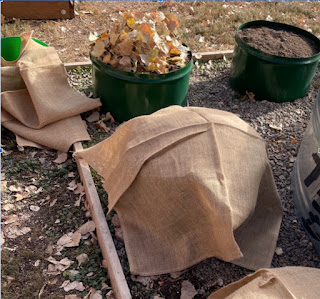The temperatures are consistently below freezing at my house and I am ready to put my gardening tools up for the season. Now I need to decide what to do with all of my unripe tomatoes that have been stuck in purgatory for most of October; not progressing under their frost blankets but also not dying. I can only handle so many fried green tomatoes and green tomato relish and salsa so I sort my tomatoes into those that will ripen off the vine and those that will not.
Some of the green tomatoes I separated for relish.
Tomatoes that are starting to develop a pink blush will ripen off the vine without any loss of flavor; this is called the breaker stage. Tomatoes that are a shiny green and have a white to light green star shape on the blossom end of the fruit have reached the mature green stage. These fruits will ripen off the vine but their flavor will not fully develop - a small sacrifice I am willing to make to eat fresh garden tomatoes well into November. Tomatoes that are a more matte green have not reached the mature green stage and will not ripen off the vine, these tomatoes can be used for green tomato recipes.
Tomato starting to develop blush color.
Once I have separated out the tomatoes I want to ripen, I remove any stems and wash and air dry the fruit on a clean paper towel out of direct sunlight. The dry tomatoes are then placed in layers 1-2 tomatoes deep in a covered box or a container with newspaper or cardboard covering them. I keep them in a dark cool location out of direct sunlight to ripen. Store the tomatoes at a temperature between 70°F and 55°F. Tomatoes stored closer to 70°F will ripen in a couple of weeks and tomatoes stored closer to 55°F will ripen in about a month. Tomatoes ripened below 50°F will be bland.
Washed, dried and ready to store for ripening.
Humidity can cause issues when ripening tomatoes indoors. Too much humidity causes the fruit to mold and too little humidity causes the fruit to shrivel. I typically have more trouble with too little humidity. To help increase the humidity, the tomatoes can be placed in a strainer or blanching pan and then placed in a covered container with water at the bottom. Make sure the tomatoes are not touching the water though. I check the tomatoes every couple of days and remove tomatoes that are ripe or nearly ripe. If I want the tomatoes to ripen more quickly I will add a banana or one or two red tomatoes to the green tomatoes.
Ripening tomatoes indoors does not need to be reserved for last ditch end of the season efforts! I try to pick most of my tomatoes when they develop that light blush color. I find that I get better yields harvesting them at this stage and then ripening indoors because I do not lose as many tomatoes to sunscald, critters, or simply missing them before they become over ripe. It may be the end of the gardening season but I am looking forward to having tomatoes all through the fall!
PlantTalk: Ripening Tomatoes Indoors

